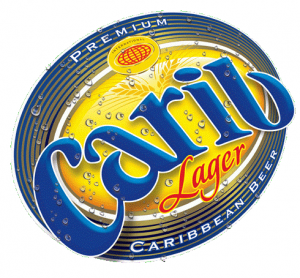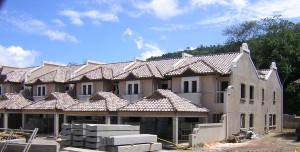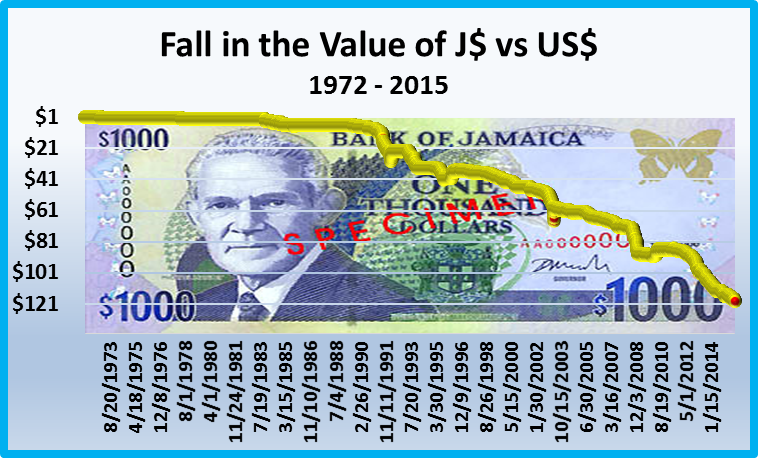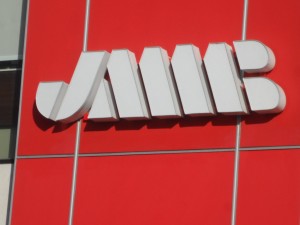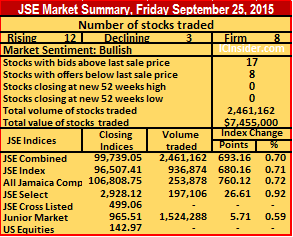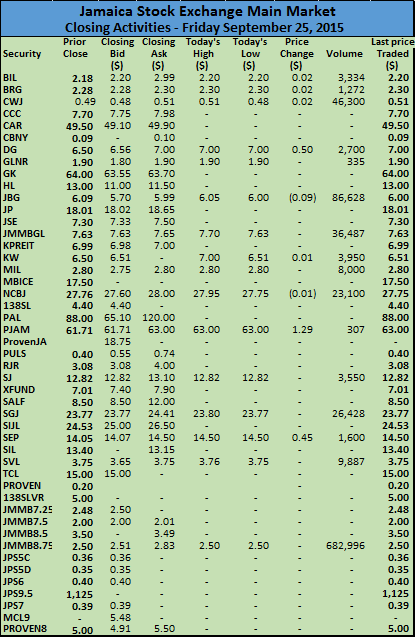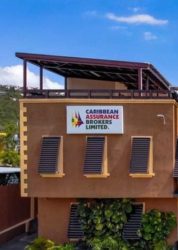The smaller economies within the Caribbean region appear to be better managed than the larger economies in the region. IC Insider.com looked at the exchange movements of Jamaica, Costa Rica, Guyana and Dominica Republic between 1972 to date, to see how they performed against each other.
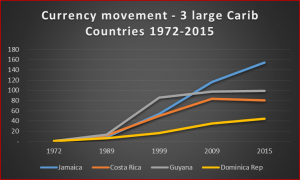 No studies appear to be have been done on this feature of the region and the major reasons why large states seems to be managed so poorly compared to the much smaller ones. The major movement in exchange rates of the countries’ currencies against the United States dollar speaks eloquently of the differences in management quality or could it be that the larger countries are much more difficult to manage? The smaller islands of Barbados, the Eastern Caribbean and the Cayman Islands have maintained the value of their currencies to that of the US from 1972 until now.
No studies appear to be have been done on this feature of the region and the major reasons why large states seems to be managed so poorly compared to the much smaller ones. The major movement in exchange rates of the countries’ currencies against the United States dollar speaks eloquently of the differences in management quality or could it be that the larger countries are much more difficult to manage? The smaller islands of Barbados, the Eastern Caribbean and the Cayman Islands have maintained the value of their currencies to that of the US from 1972 until now.
At the beginning of 1972 it took 6.635 colon to purchase one United States dollar, by 1989, the amount increased to 79.7335 colon for an increase of 12 times the 1972 value. By the end of 1999 it required 50 times the amount in 1972 or 331.796 colons to buy the US dollar. By 2009 it took 554.5 colon to buy the US dollar or 83.6 times the amount in 1972. As of September this year it requires 80.2 times the amount in 1972 to purchase the US dollar which trades at 532.45 colon to US$1.
In the case of Guyana it took GY$2.087 in 1972 to buy the Us dollar but by 1989 it required 13.4 times the amount as in 1972 as the rate slipped to GY$27.95. By 1999 it was taking GY$178.63 or 85.6 times the 1972 figure, for the next ten years the change slowed markedly to GY$202.876 or 97 times the 1972 and in September 2015 the rate inched up to GY$205.79.
In the case of Dominican Republic it took 1 peso in 1972 to buy the Us dollar but by 1989 it required 6.53 times the amount as in 1972 as the rate slipped to 6.53 pesos. By 1999 it was taking 16.09 or 16 times the 1972 figure. By 1999 the Dominican peso fell further in value, requiring 35.35 pesos or 35 times the 1972 figure to buy the buck. In September 2015 the rate climbed to 44.26 pesos to the US dollar or 44 times the amount in 1972.
Jamaica has turned out to be by far, the worst performing currency in the Caribbean region since 1972 and probably the worst managed economy. Between 1972 and September this year, it takes 154.55 more Jamaican dollar to buy one United States dollar as the country’s economy has performed poorly. Having been trading at 77 Jamaican cents to the US dollar for a number of years, by the January 10, 1973, the Jamaican dollar was devalued by 15 percent to 91 cents to one US dollar. On the January 13, 1978, the official rate had moved to $1.05, by May 10, the rate ended at $1.55 and ended at $1.69 on the last day of the year. On May 2, 1979 the rate moved to $1.78 where it stayed until November 1983, at which stage the rate moved to $3.15. By 1985 the rate climbed to $5.50 and to $6.50 by the end of 1989, taking 365 percent more Jamaican dollars to buy the US dollar, since 1983 and requiring 8.44 times the amount in 1972.
Ten years later in 1999, the rate reached $41.42, requiring 637 percent more local currency to but one US dollar than ten years before, and 53.8 times the amount in 1972. By the end of 2009, the rate moved to $89.60, requiring just over twice the amount of Jamaican dollars for one US dollar. At the end of trading on Friday September 25, 2015 at just over $119 to 1 US dollar for the first time, requiring 33 percent more Jamaican dollars to purchase the US dollar, than at the end of 2009.
Archives for September 2015
J$ slips below 119 to US$1 on Monday
 Trading ended Monday in the foreign exchange market with the equivalent of US$45,002,605 bought by dealers, compared with US$32,449,484 on Friday, while they sold the equivalent of US$35,574,946, versus US$29,004,619 previously as the selling rate for the US dollar dropped below the $119 level by 3 cents.
Trading ended Monday in the foreign exchange market with the equivalent of US$45,002,605 bought by dealers, compared with US$32,449,484 on Friday, while they sold the equivalent of US$35,574,946, versus US$29,004,619 previously as the selling rate for the US dollar dropped below the $119 level by 3 cents.
In US dollar trading , dealers bought US$40,969,765 compared to US$30,260,875 on Friday. The buying rate for the US dollar fell 8 cents to $118.37 and US$34,148,900 was sold versus US$27,678,764 on Friday, the selling rate fell 3 cents to close at $118.99.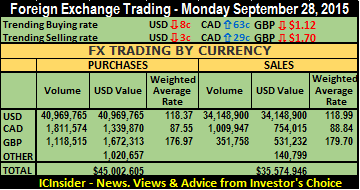 The Canadian dollar buying rate added 63 cents to end at $87.55, with dealers buying C$1,811,574 and selling C$1,009,947, at an average rate that rose 29 cents to $88.84. The rate for buying the British Pound dropped $1.12 to $176.97 for the purchase of £1,118,515, while £351,758 was sold, at an average rate that dropped $1.70 to end at $179.70. At the end of trading, it took J$132.99 to purchase the Euro, with a drop by $1.32 from Friday’s rate, according to data from Bank of Jamaica, while dealers purchased the European common currency at J$130.37, for a fall of $1.57 from Friday’s rate. The US dollar equivalent of other currencies traded, amounts to US$1,020,657 being bought, while US$140,799 was sold.
The Canadian dollar buying rate added 63 cents to end at $87.55, with dealers buying C$1,811,574 and selling C$1,009,947, at an average rate that rose 29 cents to $88.84. The rate for buying the British Pound dropped $1.12 to $176.97 for the purchase of £1,118,515, while £351,758 was sold, at an average rate that dropped $1.70 to end at $179.70. At the end of trading, it took J$132.99 to purchase the Euro, with a drop by $1.32 from Friday’s rate, according to data from Bank of Jamaica, while dealers purchased the European common currency at J$130.37, for a fall of $1.57 from Friday’s rate. The US dollar equivalent of other currencies traded, amounts to US$1,020,657 being bought, while US$140,799 was sold.
Highs & Lows| The highest buying rate for the US dollar climbed 38 cents on Monday to $119.50, the lowest buying and the highest selling rates were unchanged at $97.44 and $124.87 respectively while the lowest selling rate rose $1.92 to $99.37.  The highest buying rate for the Canadian dollar rose 31 cents to $90, the lowest buying rate gained 37 cents to $70.80, the highest selling rate climbed 77 cents to end at $92.30 and the lowest selling rate dropped $11.94 to $73.56. The highest buying rate for the British Pound, lost 80 cents to end at $180.70. The lowest buying rate, the highest and lowest selling rates remained unchanged at $145.46, $187.52 and $175 respectively.
The highest buying rate for the Canadian dollar rose 31 cents to $90, the lowest buying rate gained 37 cents to $70.80, the highest selling rate climbed 77 cents to end at $92.30 and the lowest selling rate dropped $11.94 to $73.56. The highest buying rate for the British Pound, lost 80 cents to end at $180.70. The lowest buying rate, the highest and lowest selling rates remained unchanged at $145.46, $187.52 and $175 respectively.
Weak start to the week for JSE
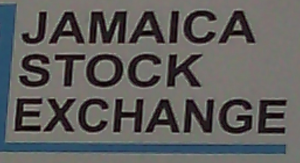 The Jamaica Stock Exchange saw low trading activity on Monday, at the close there were 11 stocks rising and 11 declining with 30 securities totalling 1,250,833 units, valued at $8,226,223 changing hands, in all market segments. Trading in the main market was very light with only 446,610 shares trading.
The Jamaica Stock Exchange saw low trading activity on Monday, at the close there were 11 stocks rising and 11 declining with 30 securities totalling 1,250,833 units, valued at $8,226,223 changing hands, in all market segments. Trading in the main market was very light with only 446,610 shares trading.
The main market indices enjoyed a second day of increases with the JSE Market Index lost 150.92 points to 96,356.49, the JSE All Jamaican Composite index declined 168.66 points to 106,640.09 and the JSE combined index fell 112.62 to end at 99, 626.43.
IC bid-offer Indicator| At the end of trading, in the main and junior 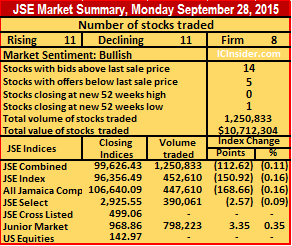 markets, the Investor’s Choice bid-offer indicator had a reading of 14 stocks with bids higher than their last selling prices and 5 with offers that were lower. This indicator has increased in strength over the past week as the period for company results for the third quarter approaches. There remain some pockets of weakness as shown by the number of stocks that are offered below their last selling prices.
markets, the Investor’s Choice bid-offer indicator had a reading of 14 stocks with bids higher than their last selling prices and 5 with offers that were lower. This indicator has increased in strength over the past week as the period for company results for the third quarter approaches. There remain some pockets of weakness as shown by the number of stocks that are offered below their last selling prices.
In trading, Cable and Wireless fell 2 cents with 6,000 shares changing hands, to close at 49 cents, Caribbean Cement had 215,450 shares trading with a 1 cent rise to $7.71, Carreras lost 40 cent in trading 11,250 shares and ended at $49.10, Hardware & Lumber traded just 797 shares to end at $11 for a fall of $2. Mayberry Investments had 13,500 units trading at $2.80,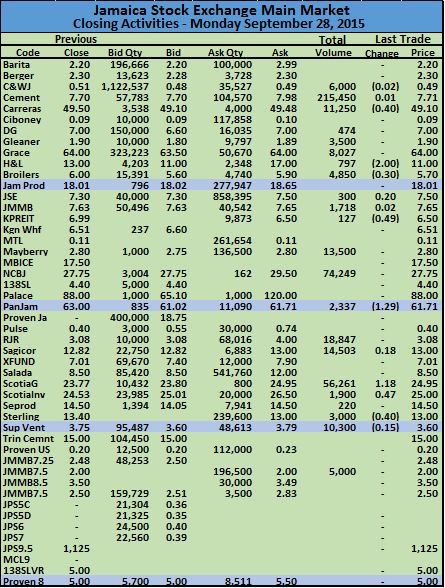 National Commercial Bank had 74,249 units changing hands and ended at $27.75, Pan Jamaican traded 2,337 shares to close with a loss of $1.29 at $61.71. Radio Jamaica traded at $3.08 with 18,847 shares changing hands. Sagicor Group with 14,503 shares closed 18 cents up, to $13. Scotia Group gained $1.18 in ending at $24.95 with 56,261 shares trading, Scotia Investments gained 47 cents to $25 with only 1,900 units, Sterling Investments ended with a loss of 40 cents to a 52 weeks’ low of $13 while trading 3,000 shares and Supreme Ventures lost 15 cents with 10,300 shares trading to end at $3.60.
National Commercial Bank had 74,249 units changing hands and ended at $27.75, Pan Jamaican traded 2,337 shares to close with a loss of $1.29 at $61.71. Radio Jamaica traded at $3.08 with 18,847 shares changing hands. Sagicor Group with 14,503 shares closed 18 cents up, to $13. Scotia Group gained $1.18 in ending at $24.95 with 56,261 shares trading, Scotia Investments gained 47 cents to $25 with only 1,900 units, Sterling Investments ended with a loss of 40 cents to a 52 weeks’ low of $13 while trading 3,000 shares and Supreme Ventures lost 15 cents with 10,300 shares trading to end at $3.60.
Juniors inched up on Monday
The junior market ended on Monday with the index rising 3.35 points to 968.86 and a total of 4 stocks advancing, 3 declining as 8 securities traded. The market ended with 798,223 units, valued at $1,792,306 changing hands.
At the close 3 securities ended with no bids to buy, while 9 had no stocks being offered for sale. A total of 7 stocks closed with bids higher than the last traded prices and 3 closed with lower offers.
In trading, AMG Packaging 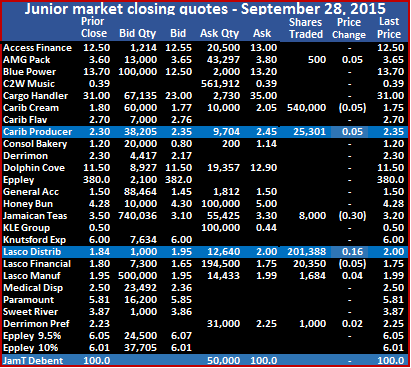 closed with a gain of 5 cents to reach $3.65, with 500 units changing hands, Caribbean Cream traded 540,000 shares and lost 5 cents to close at $1.75, Caribbean Producers traded 25,301 shares at $2.35 by gaining 5 cents. Jamaican Teas traded 8,000 units at $3.20 by slipping 30 cents, Lasco Distributors closed with 201,388 units trading and ended with a gain of 16 cents at $2, Lasco Financial with 20,350 shares changing hands ended at $1.75 after losing 5 cents. Lasco Manufacturing with 1,684 shares trading closed at $1.99 with a gain of 4 cents, and Derrimon Trading preference share ended with 1,000 shares changing hands to end 2 cents higher at $2.25.
closed with a gain of 5 cents to reach $3.65, with 500 units changing hands, Caribbean Cream traded 540,000 shares and lost 5 cents to close at $1.75, Caribbean Producers traded 25,301 shares at $2.35 by gaining 5 cents. Jamaican Teas traded 8,000 units at $3.20 by slipping 30 cents, Lasco Distributors closed with 201,388 units trading and ended with a gain of 16 cents at $2, Lasco Financial with 20,350 shares changing hands ended at $1.75 after losing 5 cents. Lasco Manufacturing with 1,684 shares trading closed at $1.99 with a gain of 4 cents, and Derrimon Trading preference share ended with 1,000 shares changing hands to end 2 cents higher at $2.25.
Moderate trading in Trinidad
Trading on the Trinidad & Tobago Stock Exchange on Monday saw very moderate market activity with the market closing having only 6 securities trading with 1 stocks trading higher, none declining and 5 remained unchanged as a total of 53,570 units traded, valued at $1,585,372.
At the close the Composite Index ending with a modest gain of 0.03 at 1,147.51, the All T&T Index rose 0.06 to 1,950.01 and the Cross Listed Index remained at 45.27.
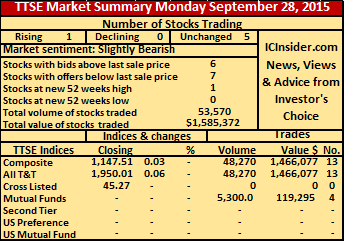 Gains| Unilever was the sole stock rising with gain of 1 cent but just 17 shares traded to end with at a new 52 weeks’ high of $67.21.
Gains| Unilever was the sole stock rising with gain of 1 cent but just 17 shares traded to end with at a new 52 weeks’ high of $67.21.
Firm Trades| Clico Investment Fund closed with 5,300 shares changing hands at $22.50, First Citizens Bank traded 22,672 shares valued at $793,744 to close at $35, Republic Bank had 444 shares changing hands at $112, Scotiabank traded 9,137 shares, valued at $571,063 to end at $62.50 and Trinidad Cement had 16,000 shares changing hands and ended at $3.15.
IC bid-offer Indicator| At the end of trading the Investor’s Choice bid-offer indicator had 6 stocks with the bid higher than their last selling prices and 7 stocks with offers that were lower.
Repo rate hiked
 Repo rates moved up by 25 basis points to 4 ½ percent in Trinidad & Tobago. At its September 2015 meeting, the Central Bank’s Monetary Policy Committee (MPC) agreed to increase the ‘Repo’ rate for a seventh consecutive time to 4.5 percent.
Repo rates moved up by 25 basis points to 4 ½ percent in Trinidad & Tobago. At its September 2015 meeting, the Central Bank’s Monetary Policy Committee (MPC) agreed to increase the ‘Repo’ rate for a seventh consecutive time to 4.5 percent.
According to the central bank, the most influential factor behind the MPC’s decision remains the normalization of US monetary policy which could reduce capital flows to many emerging market economies, including Trinidad and Tobago, which is already adjusting to persistently low energy prices. The MPC also judged the domestic monetary policy stance as still very accommodative in the context of a contracting non-energy sector and moderate inflationary pressures.
The central bank last increased repo rates in July by 25 basis points to 4.25 percent, then the bankers stated apart from similar reasons as above that locally, rising inflationary pressures remain a concern for the MPC. Headline inflation held steady at just over 5 ½ percent in June 2015, while core inflation slowed marginally to just below 2 percent. However, the MPC expects inflationary pressures to pick up in the remaining months of 2015 due to a number of factors.
The central bankers stated that domestic inflationary pressures have not materialized as initially expected. On a year-on-year basis to August 2015, headline inflation slowed to 4 percent from just over 5 ½ percent in July 2015. Core inflation was stable at just over 1 ½ percent, while food inflation decelerated to around 8 percent from double-digit territory of 11 ½ percent in July 2015. Although current price pressures seem contained, disruptions to domestic agricultural supply and higher production costs facing select food industries could lead to rising food inflation. Increased consumer spending driven in part by recently concluded public sector wage agreements, as well as robust consumer borrowing, could also push up inflationary pressures.
5 junior stocks rise 1 fall on Friday
 The junior market ended on Friday with the index rising 5.71 points to 965.51 with indications below showing that Monday should be another day of more stocks rising than declining. A total of 5 stocks advanced, 1 declined with 6 securities trading. The market ended with 1,524,288 units, valued at $3.455 million changing hands.
The junior market ended on Friday with the index rising 5.71 points to 965.51 with indications below showing that Monday should be another day of more stocks rising than declining. A total of 5 stocks advanced, 1 declined with 6 securities trading. The market ended with 1,524,288 units, valued at $3.455 million changing hands.
The market ended with 3 securities with no bids to buy, while 9 had no stocks being offered for sale. A total of 9 stocks closed with bids higher than the last traded prices and 4 closed with lower offers.
In trading, Caribbean Cream traded 20,000 shares and gained 9 cents to close at $1.80, Dolphin Cove traded 4,000 shares at $11.50, General Accident Insurance traded 24,000 units at $1.50 to gain 3 cents,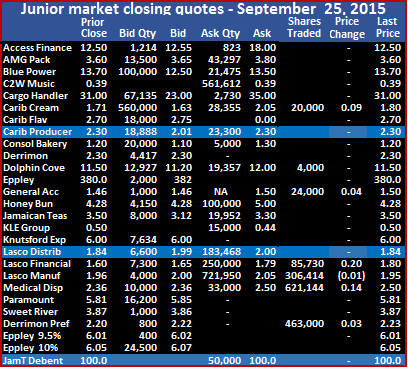 Lasco Financial with 85,750 shares changing hands ended at $1.80. Lasco Manufacturing with 306,414 shares trading closed at $2.05 with a gain of 9 cents, Medical Disposables traded 621,144 shares to close unchanged at $2.50 and Derrimon Trading preference share ended with 463,000 shares changing hands to end at $2.23. The usual trading data was not available after the close on Friday as such the volumes on the bid and offers are for the most part those at 11 am on Friday morning.
Lasco Financial with 85,750 shares changing hands ended at $1.80. Lasco Manufacturing with 306,414 shares trading closed at $2.05 with a gain of 9 cents, Medical Disposables traded 621,144 shares to close unchanged at $2.50 and Derrimon Trading preference share ended with 463,000 shares changing hands to end at $2.23. The usual trading data was not available after the close on Friday as such the volumes on the bid and offers are for the most part those at 11 am on Friday morning.
